The Robobusiness conference organized by Robotics Trends took place on Nov. 2 and 3, in Sheraton Hotel, downtown Boston. A lot of well known robotics firms were represented with their high level managers or presidents.
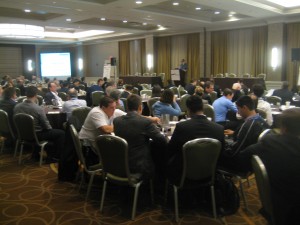 Below you can find our notes from the sessions we attended, which highlight important points and give you a brief summary of each session…
Below you can find our notes from the sessions we attended, which highlight important points and give you a brief summary of each session…
November 2
Robots that matter – Colin Angle, CEO and Co-Founder – irobot
Colin Angle discussed the importance of understanding the needs of the customers and making robots that solve real world problems, rather than spending time and money into products that look cool but can not address any needs. He gave examples from robots such as the ones that are currently being used by the military including the packbot, an explosive detonating robot, robots that can be attached to a person’s legs in order to ease movements, a seaglider robot that is used to track oceanic currents autonomously, which was used at the Gulf of mexico during the oil spill and is able to run for 9 months on single charge, an explorer robot that is used to reach hazardous areas, such as the ones used in Fukushima Nuclear Plant to clear radioactive dust and remove rubble. He underlined the necessity of focusing on the price vs. problem solved, in order to achieve success. Irobot today is one of the largest consumer robotics companies in the world, with a 2010 revenue of $400 million and has shipped $1.5 Billion worth of robots to date. The company employs 700 people. Mr. Angle stated that innovative robotics companies will change the world. He pointed out that today every 1 of 4 vacuum cleaners sold in Spain are robots. Over 4000 robots so far has been shipped to serve under military. He gave an interesting example from the population age distribution, and how we will need to have more robots in order to help seniors in the very near future. The ratio of people over 65 to the rest of the population was 1/7 in the past, and out of that 7 only 4 was able to take care of that senior. Now, the ratio is dropping and in the near future there will be only 1 person to take care of a senior over 65, which will mean an impossibility of taking care of that adult while having a full time job at the same time. This highlights an important point about how much we need these robotic helpers very soon.
US Army Ground Robotic’s Role in the Emerging Intelligent and Autonomous Transportation – James Overholt, Senior Research Scientist – US Army Tardec
In 2004 there was 162 robots used in military which were also expensive. With the increased Autonomy of Robots, the soldier reach has expanded. Ground Robotic realities have been discussed and it was reminded that robots are all remotely controlled, difficult to control, robots can not work efficiently in unstructured environments, they can’t keep up with a charging soldier’s speed. Optionally manned vehicles have been discussed. The goal, which was set in 2001, is to have 1/3 of all the ground vehicles unmanned, by 2015. Right now there are 4000 unmanned vehicles out of 600,000. Mr. Overholt emphasized that the robotic technology should be incremental and evolutionary, and probably will not be revolutionary, and it is important to have return on investment, while advancing this technology. The importance of preventing convoy fatalities have been discussed. 1 in 8 fatalities in Iraq and Afghanistan have been convoy fatalities so far. Robotic Range Clearance Competition, was discussed, which is a cash prize competition for developing robotic technology to automate removal of vegetation debris and unexpected ordinance (UXO) from training ranges. The categories have been listed as: vegetable clearance, geophysical mapping, surface and subsurface clearance. Every category’s winner received a cash prize of $250,000. During operation of robot vehicles, there exists different type of environments and the tasks vary accordingly. For instance, the environment can be divided into two, structured and unstructured. Also there is the human intent, which can be classified as benign vs. hostile. Under all of these different conditions, robots need to perform different tasks. Mr. Overholt stated that robots are enablers and catching out, mainly as force multipliers, but not replacing the force structure yet. He brought up a recent project called Robot Town where human-robot interaction will be measured in real life.
Robotics in Education – Paul Copioli, President – VEX Robotics
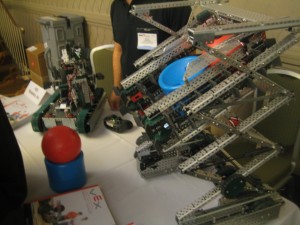
In order to solve robotics problems, talented, educated people are necessary, but these people are hard to find. There has been a shortage of STEM (Science, Technology, Engineering, Mathematics) workers in the US versus the need. Increasing the talent pool is necessary in order to solve this problem. Out of every 100 students who test high in Mathematics, only 25% pursue a STEM degree. Out of this portion, only 50% graduate and within this group 50% actually work in a field related to their degree. This shows that increasing the talent pool as early as possible is absolutely critical in order to overcome this problem. VEX Robotics, which produces Robot Kits for students, aims to broaden the base of students that are interested in these fields. Extra Curricular Competitions can also help to attract students to this subject. Among the competitions, BEST, VEX, FIRST competitions can be counted as major ones.
Business Opportunities in Personal and Service Robotics Industries – Dan Kara, Conference Chairman – Robobusiness Leadership Summit
The Macrotrends and Commercial opportunities in Research Robotics Market have been discussed. Increasing Autonomy is becoming increasingly apparent in every field, therefore all industries must define their goals accordingly. Among the subjects discussed were, Level of Autonomy vs. Modes of Control, Task Autonomy, Power Autonomy, Failure Autonomy, Guidance and Navigation Autonomy, Security and Defense and Autonomy were mentioned. It is important to understand that Technology roadmaps can provide insights into future opportunities.
Benefits of Having ODM / OEM partner in the early stages of product development – Steve Ohler, Senior Vice President – US Office – Jetta Company Ltd.

Outsourcing a product idea in order to make it ready for production is critical in order to achieve success. The stages of development leading to production has been discussed. They can be summarized as follows: Concept Approval, Preliminary Design, Functional Mockup, Engineering Development, Proof of Design, Works Like / Looks Like Prototypes, Market Research, Engineering Release for Quotes, OEM Selection, Tool Build, First Shots, Debug (EP-PP), Production Start. The benefits of having a product development company to make a product idea a reality can be summarized as follows: Design for Manufacturability, Design for Cost, Design for Abuse and Reliability, R&D Capabilities, Budget, Relationship Building. All of these items would have been much harder and expensive to do, without hiring a product development partner. The benefits of hiring these companies will in most cases ensure a lower cost of product, therefore higher profit margins in the long run.
Technology Transfer and Partnerships to Accelerate Growth – Alan Fisher – Assist. Manager – Fujisoft Inc., Kevin Kalb Project Manager – JETRO Chicago, Marek Michelowski, – President – Beatbots LLC
In order to achieve success in Robotics Product development, partnerships are often necessary. This presentation discussed the subject in general and gave guidelines about how some arrangements have been made in the past. Trade and Business relationships with Japan have also been discussed.
Robonaut 2 and Next Generation Industrial Robots – Roland Menassa, Group Manager of Advanced Robotics – General Motors
The history of General Motors with Industrial robots date back 1954. Today we still do not see enough robots on assembly lines, due to limited sensing and low intelligence capabilities. Robonaut2 project was started in order to facilitate research and development of such robots. The project started in 2007 and the robot was sent to space in order to help astronauts in 2011. Robonaut2 (R2) has 42 DOF, 350 sensors and weighs 330 pounds. Hand Dexterity, Hand Force Control, Tactile Sensing, Haptics, Arm Force Control, Strength, Vision Platform, Human Interaction and Human Interface were among the topics explored in this project. It was stated that for next generation of industrial robots, a new approach is needed. A typical assembly plant has 60 vehicles / hour and GM has 170 plants in the world. At the last stages of manufacturing, still humans are needed due to complexity of the tasks. Robotics Vision and Goals has been discussed. In order to make robots useful, flexible perception (cognitive perception in real time and dynamic environments), manual dexterity, learning adaptation and social integration is needed. On our journey to people and robots working together, a new technology leap is needed. R2’s most impressing ability is to recognize certain tools no matter how they are placed, hold them and manipulate the object as needed. The example given was a handheld drill which R2 is shown to pick up in various arbitrary positions and take out certain parts off the tool successfully. As a conclusion, where we need to aim is to make next generation robots which must be capable of learning new abilities with basic human user training, and not complicated definition of tasks in predefined environments.
November 3
Robotics and Automation as an Enabler to Agricultural Systems Productivity – John Reid, Director – John Deere
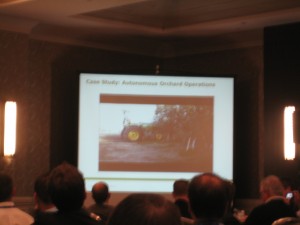
One of the most known players in Agricultural Machines, John Deere’s robotic agricultural products date back to 1999. The goal is to develop autonomous solutions for farm sites, work sites and home sites. Enabling Technologies, Demand Factors, General Constraints, Competing Solutions, Regulatory Factors, Required Resources are the main parameters in determining where we need to go. Machine sync technology has been introduced, where the operator automatically controls location of tractor and grain cart where unloading takes place at the same time. Formation Driving has been discussed, where coordinated vehicles move together with a lead vehicle. The fact that there is still enough efficiency using partial automation is slowing down the progress of full automation. Transferring to full autonomy requires change in business model, new capabilities are required in all parts of business, requires a clear understanding of customer experience you want to provide, significant changes in support model and need a clear understanding of what is being sold. Regulatory factors such as Safety and Autonomous Machines regulations need to follow advancing technology. Examples of machines discussed were Orchard Tree Spraying, and Orange Grove Management.
Making Mobile Robotics a relevant solution in Business world – Aldo Zini – President and CEO, Aethon
Aethon produces indoor transportation robots for hospitals that help nurses and other staff in moving things around accurately where and when needed, keeping the necessary documentation at the same time. The main obstacles to more frequent use of robots in commercial applications are, difficulty in unstructured environments, and the fact that most people are not skilled enough to use them. Mr. Zini highlighted the importance of making robots which should not require skilled users but be invisible to an average user while doing its task at the same time. The criteria for commercialization should start with a real world problem, keeping the focus narrow, doing an extensive market research, develop specifications that address the problem, bringing in the industry experts, engage in active research in robotics, software and hardware. The Aethon hospital robot looks more like a cart and has a simple user interface and it did not need to have a smiling face or other “cool looking” features that do not really add any value in order to function for instance. The main steps involving the design were, designing the navigation of a robot pulling a cart, designing for different type of elevators, designing for reliability and fleet management. Aethon is currently used in 135 hospitals nationwide with over 4000 robots deployed. Collectively the robots do 50,000 deliveries in one week. Tracking system Medex tracks deliveries and documents electronically. The company is expected to grow by 60% in 2011. Conclusions were that full scale autonomous robots are not 10-15 years away, but with proper focus and product design, they can be built today. Using these robots in other industries such as retail, supermarket is also possible. Aethon robotic helpers are not considered a medical product regulated by FDA.
Partnership and Investment opportunities in Denmark – Claus Risager, Head of Center – Danish Technological Institute, Center for Robot Technology
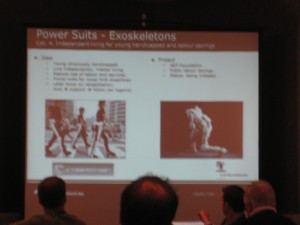
Danish Technological Institute was founded more than 100 years ago and today facilitates development of different types of robots that can be used in daily life. Various types of robots were discussed and introduced by a video showing them in action. The robots introduced were: An automated cost effective system that handles medical sterilized devices, Vacuum Cleaning Robots, Intelligent Compressive Garbage Cans, Eating Assist Robots, Powersuits/Exoskeleton, Intelligent Toilets and Lifts, Towel Handling Robot, Bathing Robot for Nursing Homes, Hybrid Gripper, Unique Concrete, Apple Picker, Bin Picker, Robot Apprentice, Robot Seal, Telepresence and Telemedicine, Robot Games for Elderly. Mr. Risager emphasized how all of these can help reduce the workforce needed that would otherwise be necessary to do these dull tasks.
Robotic Technology Consortium
The organization was formed in May 2008. It involves 65 companies, 50 prototyping projects for a total of $40 million. The purpose of the organization is to provide a roadmap for US Robotics. You can visit the website at www.us-robotics.us to get more information. It was noted that the robotics technology has arrived and initial level of commercialization has started. It is expected that in the coming decade, mass production of commercial robots will increase a great deal and consumers will start to get introduced to technology. National Robotics Initiative has been discussed, which was announced June 24, 2011. The goal of the project is to develop next generation of robots that will work seamlessly with humans to enhance human life. NRI research areas and Unifying Mechanisms was mentioned. One of the main goals of unification is to establish open system robotics architecture and common hardware and software platforms. NRI Proposal project is anticipated to award 60-75 project a year.
Robot Operating System (ROS) and Open Source Robotics – Chad Jenkins – Assoc. Prof. – Brown University, Ryan Gariepy – CTO – Clearpath Robotics, Llyod Spencer – President & CEO – Coroware
The importance and benefits of having an open source robotics software system was discussed. ROS started in 2007 with zero nodes and now it has 3000 nodes and growing. Even now ROS is starting to become very useful in reducing the support costs, reducing training time, speeding up the prototyping process. In the future, it will ensure interoperability, improve system reliability and increase modularity. Robotics needs a common interface to robot middleware. The user interface is built on robot app, which in turn is built on Robot Middleware. In order for this to communicate with the robot platform, an operating system is needed such as ROS. It can be compared to Apache Servers in Web for better understanding the process.
Novel Low Cost Technology Enablers for Commercial Robotics Systems – Alexandra Dopplinger, Global Marketing Manager – Freescale Semiconductor, James Hunt – CEO – AICAS, Stathis Papaefstathiou – General Manager of Microsoft Robotics
Microsoft Robotics Studio (MSRS) was discussed, and one of the most important benefits is to create a simulation environment where it enables real world problems to be solved without actually building the robot. More and more value added in Robotics is becoming software. MS Kinect was discussed , which made recognizing visual input trivial for a robotic system. The input which will come from MS Kinect combined with improved software will enable advancement of Robotics and AI. AICAS software system was discussed, which is an object oriented software development environment and an analysis tool. Freescale Semiconductors pointed out the importance of a combined effort of the industry for software and application safety. Multi core technology will also be a game changer and in addition we need to write language that can handle massively parallel environments. MSRS has been written from the beginning to benefit from the cloud. It was stated that the balance between shared cloud computing and reliability must be established and sometimes there can be local cloud computers as there might be speed problem with a more generalized approach.
And here are some pictures from the exhibit area of the event:
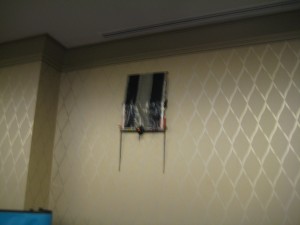
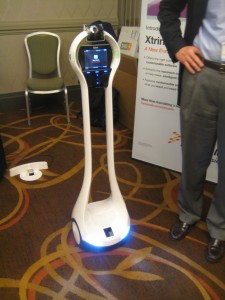
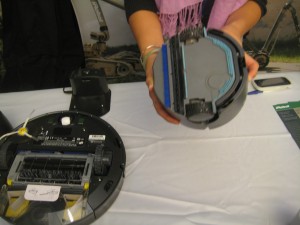
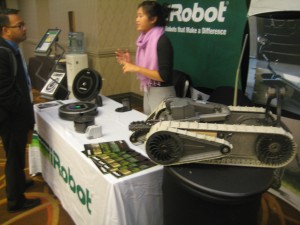
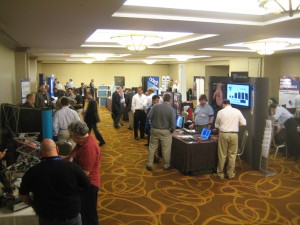
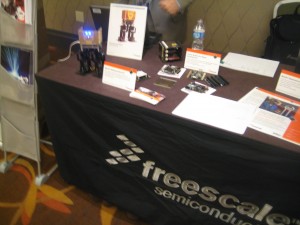
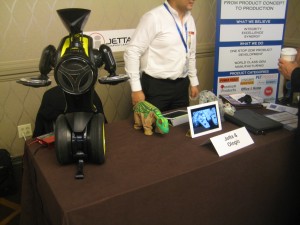
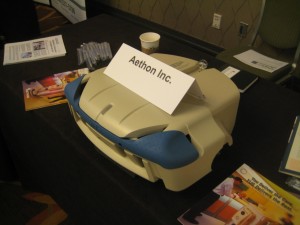
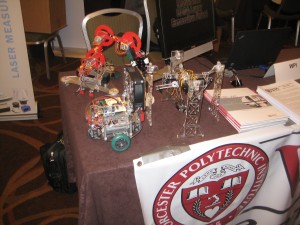

You must be logged in to post a comment Login